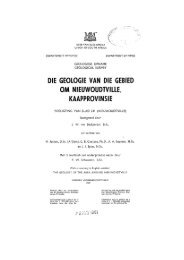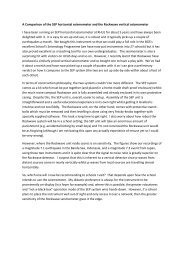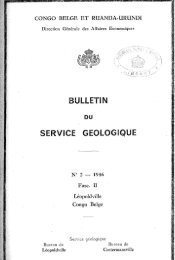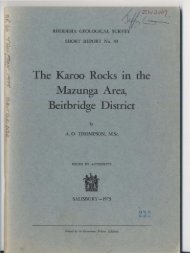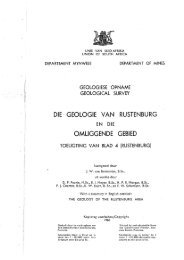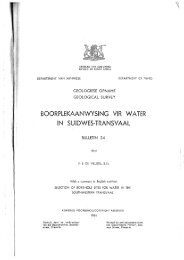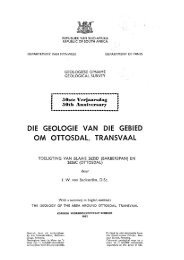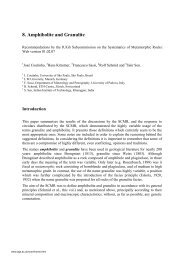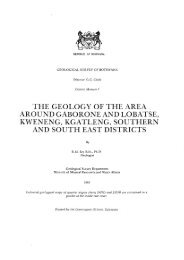Bibliography - British Geological Survey
Bibliography - British Geological Survey
Bibliography - British Geological Survey
You also want an ePaper? Increase the reach of your titles
YUMPU automatically turns print PDFs into web optimized ePapers that Google loves.
discoloration in 1877, a year before the tunnel was sealed to visitors, and had attributed it to an ‘exudation’<br />
from the corpses of chained prisoners. This phenomenon was no longer visible when Dawson and Lewis<br />
reopened the tunnel in 1894. Luckily, Dawson himself had visited the tunnel in 1872, when he would have<br />
been about eight years old, and had such a clear memory of the ‘striking and unmistakable’ human forms<br />
that he was able to make a drawing of them, which appears as Diagram No. 6 in the paper. The significance<br />
of these shadow-markings is played down in the text, presumably at the insistence of Lewis. The carefully<br />
drawn plans which accompany the paper, together with their calligraphic labelling, are the work of Lewis.<br />
Photographs are by Dawson, though probably retouched. See Russell 2003, 41–48, for a full discussion.)<br />
Dawson, C. & Woodward, A. S. 1912. On the discovery of a Palæolithic human skull and mandible in a<br />
flint-bearing gravel overlying the Wealden (Hastings Beds) at Piltdown, Fletching (Sussex). Abstracts of<br />
the Proceedings of the <strong>Geological</strong> Society of London, no. 932 (28 Dec), 20‒27. (Abstract of paper and full<br />
record of discussion, with contributions from Sir Ray Lankester, A. Keith, W. Boyd Dawkins, W. L. H.<br />
Duckworth, Clement Reid, D. Waterston, A. S. Kennard, R. A. Smith, and E. T. Newton; includes details<br />
of specimens exhibited. See Dawson & Woodward 1913a for full text of paper and reprint of discussion.)<br />
Dawson, C. & Woodward, A. S. 1913a. On the discovery of a Palæolithic human skull and mandible in a<br />
flint-bearing gravel overlying the Wealden (Hastings Beds) at Piltdown, Fletching (Sussex). Quarterly<br />
Journal of the <strong>Geological</strong> Society of London, 69 (1) issued 25 Apr, 117–151 (with discuss), plates XV–XXI<br />
(some folded). (Paper read before the <strong>Geological</strong> Society, 18 Dec 1912, at which the first formal announcement<br />
of the Piltdown findings was made. The human skull and accompanying ape-like jaw are referred to<br />
Eoanthropus Dawsoni, gen et sp nov; with a ‘Preliminary report on the cranial cast’ by G. E. Smith, pp. 145–7)<br />
Dawson, C. & Woodward, A. S. 1913b. Supplementary note on the discovery of a Palæolithic human skull<br />
and mandible at Piltdown (Sussex). Abstracts of the Proceedings of the <strong>Geological</strong> Society of London, no.<br />
949 (31 Dec), 28–31. (Abstract of paper and full record of discussion, with contributions from A. Keith, W.<br />
J. Sollas, W. Boyd Dawkins, and A. S. Underwood; includes details of specimens exhibited. See Dawson &<br />
Woodward 1914a for full text of paper and reprint of discussion.)<br />
Dawson, C. & Woodward, A. S. 1914a. Supplementary note on the discovery of a Palæolithic human skull<br />
and mandible at Piltdown (Sussex). Quarterly Journal of the <strong>Geological</strong> Society of London, 70 (1) 25 Apr,<br />
82–99 (with discuss), plates XIV–XV. (Paper read before the <strong>Geological</strong> Society, 17 Dec 1913; the principal<br />
new findings included some nasal bones and a lower canine tooth; with an appendix by G. E. Smith ‘On the<br />
exact determination of the median plane of the Piltdown skull’, pp. 93–97.)<br />
Dawson, C. & Woodward, A. S. 1914b. On a bone implement from Piltdown (Sussex). Abstracts of the<br />
Proceedings of the <strong>Geological</strong> Society of London, no. 965 (10 Dec), 15–18. (Abstract of paper and full<br />
record of discussion, with contributions from G. F. Lawrence, W. Dale, Reginald Smith, E. A. Martin,<br />
A. S. Kennard, F. P. Mennell, and S. Hazzledine Warren. See Dawson & Woodward 1915 for full text of<br />
paper and reprint of discussion.)<br />
Dawson, C. & Woodward, A. S. 1915. On a bone implement from Piltdown (Sussex). Quarterly Journal of<br />
the <strong>Geological</strong> Society of London, 71 (1) 17 Sept, 144–149 (with discuss), plate 14 (folded). (The strange<br />
‘implement’ described here had evidently been carved from the limb-bone of an elephant. In the discussion<br />
that followed the reading of this paper, Reginald Smith of the <strong>British</strong> Museum stated that ‘it would rank as<br />
by far the oldest undoubted work of man in bone...’, but added that ‘the possibility of the bone having been<br />
found and whittled in recent times must be considered.’ He could not imagine ‘any use for an implement that<br />
looked like part of a cricket-bat.’)<br />
Dawson, C. (See also Woodward 1911. For other papers by Dawson not listed here see Farrant.... The<br />
Charles Dawson Collection, held by Hastings Museum and Art Gallery, consists of two boxes of documents,<br />
two boxes of finds and some larger objects. For a full list of contents see:<br />
http://www.nationalarchives.gov.uk/a2a/records.aspx?cat=509-hasmg&cid=-1#-1 )<br />
Dawson, W. R. (ed.) 1938. Sir Grafton Elliot Smith: a biographical record by his colleagues. London:<br />
Jonathan Cape, 272 pp, 4 plates. (Ch. I: General biography, by W. R. Dawson, refers to Elliot Smith’s<br />
examination of the Piltdown skull and visits to the site, pp. 59–60. Ch. VI: The Manchester period, by J. S.<br />
B. Stopford, briefly describes the excitement in the Department of Anatomy at University of Manchester<br />
where Smith was Professor of Anatomy at the time of the Piltdown discovery, p. 160. Full list of published<br />
works, pp. 219–253.)



